 Research problems, in a way, are like log jams. For a long time they seem to present an unbudgeable wall. But let the water get through one little are by dislodging a few logs, and it is only a matter of time before the whole edifice gives way. Mixtec lienzos are a case in point. Until recently they have provided Middle American experts with some fairly formidable jams. But some water has been getting through them now that it is known that these lively sixteenth-century native records painted on cloth combine the features of maps, histories, and genealogies.
Research problems, in a way, are like log jams. For a long time they seem to present an unbudgeable wall. But let the water get through one little are by dislodging a few logs, and it is only a matter of time before the whole edifice gives way. Mixtec lienzos are a case in point. Until recently they have provided Middle American experts with some fairly formidable jams. But some water has been getting through them now that it is known that these lively sixteenth-century native records painted on cloth combine the features of maps, histories, and genealogies.
The people from the Mixteca in northern Oaxaca are not the only Mexican natives who, in the sixteenth century, made a point of working in their old artistic traditions to preserve their past on multiple-purpose sheets. But by and large, the Mixtecs, having the greatest artistic gifts in this direction, have created the finest lienzos. And the Mixtec lienzo in the University Museum provides a nice case study both of how these sheets have resisted decipherment and of how they are now beginning to yield their secrets.
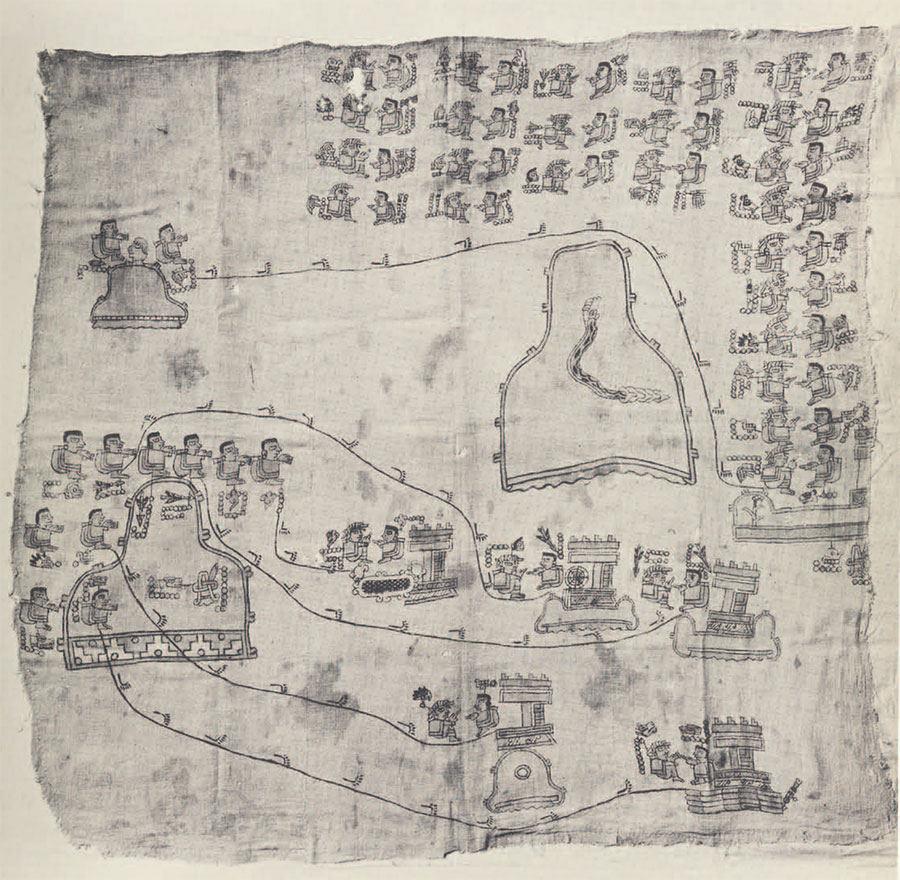
The Museum acquired it in 1942, published it the next year, and has long had it on display on its main floor. Yet only recently has there been a significant break-through in its reading. It has been made by the great Mexican scholar, Alfonso Caso. Actually, Dr. Caso brought his formidable interpretative powers to bear on the lienzo some time ago, but it was only towards the end of last year that he published an article on it that loosens some of its key logs.
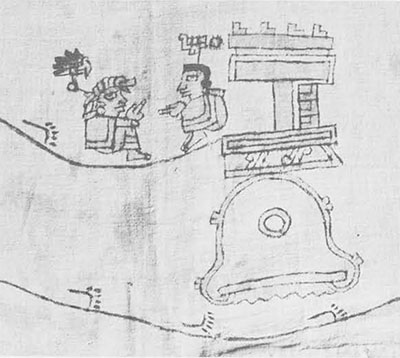
Look, for instance, at these two figures (2 and 3). The one on the left shows a couple from the Museum’s lienzo; the other shows a couple from page 16 of Codex Nuttall. The lienzo pair face each other in front of a temple, while the codex pair are stacked, one above the other, in front of a white tree. But thanks to Dr. Caso’s sharp eyes, we can now see for ourselves that each document shows the same couple. How do we see it? By studying the motifs attending each. With the woman it is an eagle’s head linked by a line to a disk; with the man it is a form like the lower jaw of a skull, also linked to a single disk. The disks are numbers and the motifs are primarily calendric day signs, but they reveal the persons’ names, for it was the Mixtec custom to name a child for the day on which it was born; a custom, incidentally, which explains why male and female names are undifferentiated. In this case, the woman is Lady 1 Eagle. The man is Lord 1 Grass, for the mandible-like form is the Mixtec sign for grass, and the logic of this can be seen more clearly in the Nuttall version where the blades of grass wave above the teeth.
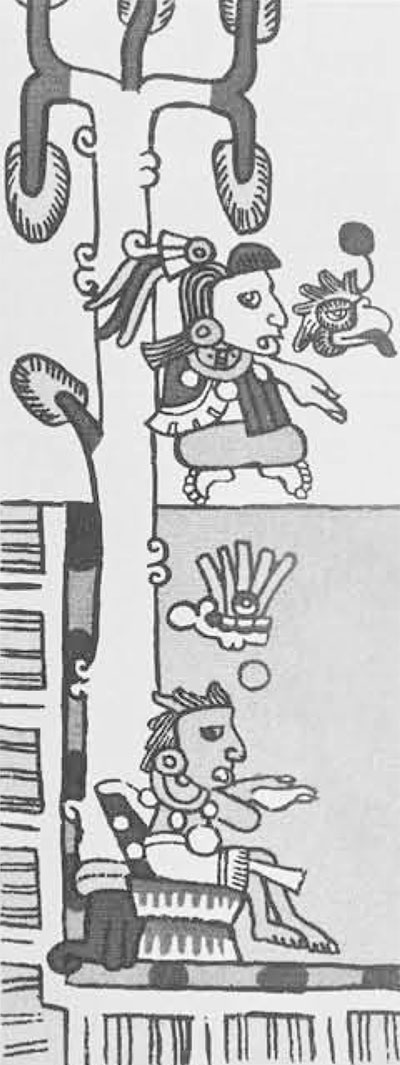
Bringing to our attention that this couple in the Philadelphia lienzo is the same couple as the couple in Codex Nuttall is an example of the sort of log-loosening that Dr. Caso has done. What makes this move so important is that for the first time it securely links the Philadelphia sheet, which is probably a post-conquest document, with the great pre-Conquest Mixtec pictorials painted on deer-hide. Before, because of its artistic style, we assume it was related to those pictorials. But now we know it is.
This proof is going to let a lot of water through the lienzo’s problems. For one thing, it will make possible to bring to it the considerable historical information that Dr. Caso has unlocked in the course of deciphering the pre-Conquest codices. For another, it will also allow us to study the lienzo with geographical insight. The nine people-attended glyphs drawn on the lienzo (five are shown with single cusps and two with double cusps) are all places. And sooner or later we will know where those places are located; for we know from the study of comparable lienzos that such glyphs represent towns that in many cases still survive.
Dr. Caso tends to move gingerly where geography is concerned, but his paper also makes geographical contributions. While they are by no means conclusive in determining the place the lienzo came from, they hold out the promise of ultimate solution. And, in a fascinating way, they link this lienzo still more unshakably with the codices in which Lord 1 Grass and Lady 1 Eagle play their notable parts.
Again, let us look at the figures that reveal relationships that Dr. Caso’s paper has brought to our attention (Figs. 4,5).
As before, the detail on the left is from the Philadelphia lienzo, but in this case the one on the right is from another of the deer-hide pictorials, Codex Vindobonensis (p.45). What do the two palace glyphs have in common? Clearly it is the checkered field. Note that in the Philadelphia lienzo the reigning couple of this place are Lord 5 Flower and a Flower wife, for again the little circles are numbers and the fleur-de-lis motif beside each is the Mixtec sign for flower. Because of a hole in the cloth, only eleven circles can be seen of the wife’s name. But we can surmise she is Lady 13 Flower because two more circles could fit in the space taken out by the hole, and the segregation of the last three dots suggests a division made for the sake of readability from a row of five. Besides, there is evidence that she is a 13 Flower, as we will see when we discuss how five men seem to turn into women.
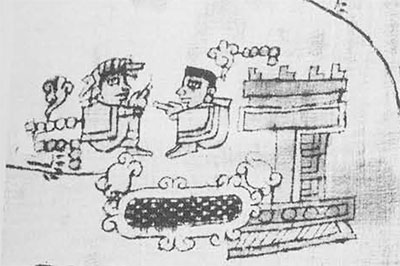
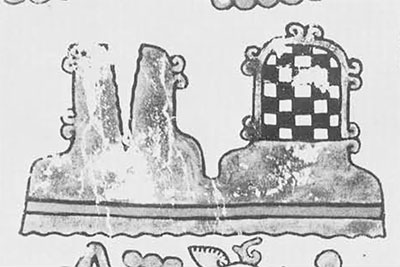
Now contrast the next figure on the left (Fig. 6) from the lienzo with the one on the right (Fig. 7) from page 7 of Vindobonensis.
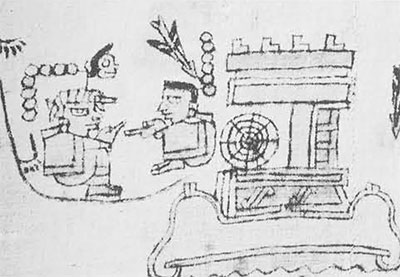
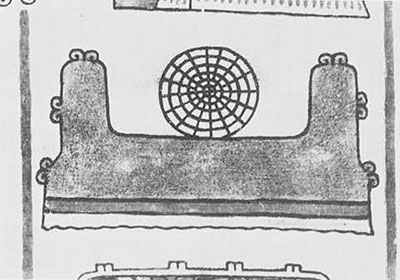
Here the obvious circles subdivided by crosses which Dr. Caso identifies as a cobweb. And here the parallel is strengthened by the fact that in each instance the cobweb is shown on a flat area between two hills. Dr. Caso shows this place also occurs in Codex Nuttall–twice, in fact, on pages 38 and 57. Note that in the lienzo the rulers of this place are shown as Lord 6 Reed and Lady 8 Monkey. Here the pictorial evidence of the woman’s motif is so directly representational the logic is plain. In the case of the man, we know the arrow signifies Reed because arrow shafts were made of reed. Note, too, that in this instance, as in the two previous details shown from the lienzo, the man and wife are seated in front of a temple, which anyone who has been to Mitla will recognize as such.
Getting back to Lord 1 Grass and Lady 1 Eagle, Caso provides another happy geographical insight into the Philadelphia lienzo. Namely, that this Hill of the Circle is not the only city-kingdom this important couple dominated. As already shown, he found them at the Place of the White Tree in Nuttall, and on page 16 of Vindobonensis (reproduced as Fig. 8) he found them at what he calls the Island of the Ashes, because the hill of periods and black spots is an ash and cinder covered hill rising from a lake.
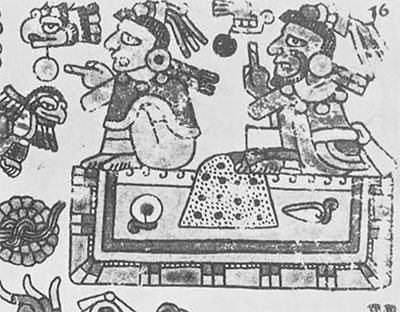
Dr. Caso also calls attention to the fact that elsewhere in Vindobonensis (pp. 33 and 34) the couple is shown at still another place, which he calls Bulto de Xipe (Bundle of the God Xipe).
A place in the lienzo to which Caso pays a good deal of attention is the one he calls Cerro de la Cabeza because of the head on top of it. It can be isolated at the top left and has two men seated at it. The man at the back is Lord 8 Flint (the lens-shaped object is the Mixtec symbol for a flint knife). The one at the front is Lord 11 Wind (the bearded, out-shooting lips with the exposed tooth, being associated with the wind god, is a sign for Wind).
Caso calls attention to places with heads on them in Nuttall, Vindobonensis, Codex Bodley, Codex Selden and another lienzo (Seler II). We cannot be sure that the places in the other documents are the place of Philadelphia’s lienzo, for they do not share a feature of the Philadelphia glyph that Caso does not point out–the closed eye that indicates death. But we hardly need this further parallel to link Philadelphia’s lienzo to the codices. This Hill of the Head with the Closed Eye, however, has importance for the Philadelphia story. As Caso points out, it provided the queen mother for the dynasty the lienzo celebrates.
One knows this because that woman, Lady 10 Wind, is shown to the right of the lienzo as the wife in the first series of 24 couples that rise above her in a reversed, upside-down ell. That she comes from the Hill of the Head with the Closed Eye is shown by the footprints that depict her journey. Undoubtedly, she was the daughter of Lord 12 Wind. Dr. Caso cites the other figure of the hill town as Lady 8 Flint, and claims her as the bride’s mother. Because of the curious changing sex that appears elsewhere in the lienzo, he may be right. But 8 Flint’s short hair and cloak knotted at the shoulder are clearly the signs of a male figure. This researcher prefers to think that in this case only the bride’s paternal forebears are shown and that the 8 Flint depicted is the grandfather, rather than the mother of the bride.
And now that the attention has been centered on the bride, one can point out that Dr. Caso concludes that the place where she is seated is the principal place of the lienzo, and probably the place where it came from. Because of the realistically depicted flowering corn stalk that grows in the hill just under the bride, he calls the place Cerro del Maiz (Corn Hill). He notes that in the days when the lienzo was complete this place, too, had its temple–and a larger one than at the other places. The back profile of it can be seen at the severed edge of the cloth.
Knowing these lienzos are generally maps as well as histories, Caso makes the point that to get to Corn Hill its First Lady undoubtedly had to skirt or cross over an intervening high hill, the one with the realistically depicted curving serpent, which is complete down to the meticulously observed rattles. And it is worth noting that it is this place glyph of the serpent (coatl) in the hill (tepetl) that led a member of the museum to christen the document Lienzo de Coatepec. But Caso rejects this designation on the grounds that Serpent Hill is not so important as two of the other places on the lienzo. He prefers to call the document Lienzo de Filadelfia because of the city in which it has found a well-guarded home.
The bride, as everyone knows, is the chief attraction at a wedding. But for a dynasty to come into being there has to be an important groom. Thus it behooves us to take a look at the man Lady 10 Wind came to marry. His day sign, too, is realistically explicable. He is Lord 3 Dog. Shrewdly, Caso notes there are no footprints to indicate either how he got to Corn Hill or to which of the other couples he is related. But it is Caso’s guess that the parents of the groom might be Lord 12 Reed and Lady 11 Reed, since they are the couple closest to him. Their temple, in fact, almost abuts Corn Hill.
Under Corn Hill there is an A interlaced with an O that enables us to recognize the existence of a Mixtec date at the incomplete edge of the lienzo. Enough of the object piercing into it diagonally can be discerned to see the year in question is a Reed year. Three of its dots are visible. Caso believes it is the year of the wedding of Lord 3 Dog and Lady 10 Wind. He places it around A.D. 1100. He reaches this figure by making two assumptions suggested by comparable lienzos. First, that the lienzo was painted in the middle of the sixteenth century; and second, that the last man and woman of the dynasty were alive at the time of the painting. (It may have been to prove their titles and land claims that they had the lienzo made.) Allowing twenty years for each of the twenty-four reigns, Caso gets a total of 480 years. This rough estimate, subtracted from the period assumed for the painting, lands near 1100; or, as we would be inclined to think, not long after the Norman Conquest of Britain.
Caso has worked out a marvelously useful correlation of Mixtec and Christian dates. The two nearest 3 Reed years to his assumed 1100 are 1067 and 1119. But he admits the possibility that, because of incompleteness, the year might be a Reed year of larger enumeration, perhaps an 8 or a 13 Reed year.
Because of the examples of other Mixtec documents, Dr. Caso believes that the generations Lord 3 Dog and Lady 10 Wind gave birth to–that is, after the first nine–should be read in a down-up, down-up order. A list of their names, given in his sequence and with three names corrected to what they were in his notes before typos crept in, is appended to this article. But the significant thing to be noted here is that Dr. Caso, despite his enormous cross reference file of the personages in the codices, lienzos, maps, and other early Mexican pictorial documents, could not find one of these 48 rulers of Cerro del Maiz elsewhere. The Philadelphia dynasty, then, is either one not shown or not recognized on any other pictorial that has yet come to light.
Perhaps the references to a curious changing of sex piques the reader’s interest. If so, let us turn to it. This requires looking first at three of the men among the ten seated near the lienzo’s second largest hill in the lower left corner. They can be found readily enough by the lines of footprints. Looking at the second line from the bottom, one finds at the left end of the line another representation of our friend Lord 1 Grass. And note the name of the male companion seated behind him: another familiar name, 1 Eagle. Well, what happens when 1 Grass migrates? Following the line of his footprints, one sees him at the Hill of the Circle with a companion of the same name as at the old place, 1 Eagle. But here 1 Eagle is clearly a woman. Besides her long skirt and out-hanging blouse, she has ribbon-braided hair.
Now look at the fifth footprint line. At the left extremity, Lord 6 Reed is seated in front of his male companion, 8 Monkey; at the right extremity one sees the same Lord 6 Reed seated with a companion of the same name as at the old place, but here again the sex is different. Now 8 Monkey is a woman.
The fourth footprint line, the very short one, suggests a similar story. The migrating Lord 5 Flower, once he gets to the Checkered Place, has a female companion whose name appears to be the same as that of the male friend in the former place. She is the lady whose name is partially obliterated by a hole, and now it can be seen why she was surmised to be 13 Flower. Because of the other sexual changes, one can assume she is the female version of the 13 Flower who was Lord 5 Flower’s companion at the first place.
A possible explanation is that the three migrating lords married women at their new homes with the same name as men friends, or perhaps fathers, they left behind. But the same thing happening three times stretches the arm of coincidence. And although there are only three instances of change of sex where the names of the leading males are identical, there are indications of sexual change in the other two couples, too. The name of the migrant lord changes from 9 to Lizard in the first line and from 13 to 12 Reed in the third line, so these men might not be the same men at both places. But the companions’ names, 9 Serpent in one case and 11 Reed in the other, remain unchanged even though their bearers are male in one place, female in the other.
With these two, one might hazard the guess that Rosalinds, dressed as boys, migrated to new towns where they revealed their true sex in getting married. But this seems unlikely, and the footprints suggest the men at the new places are the same men who set out, even though their names change by one number. One says this because the footprints definitely connect the differently-named men to each other.
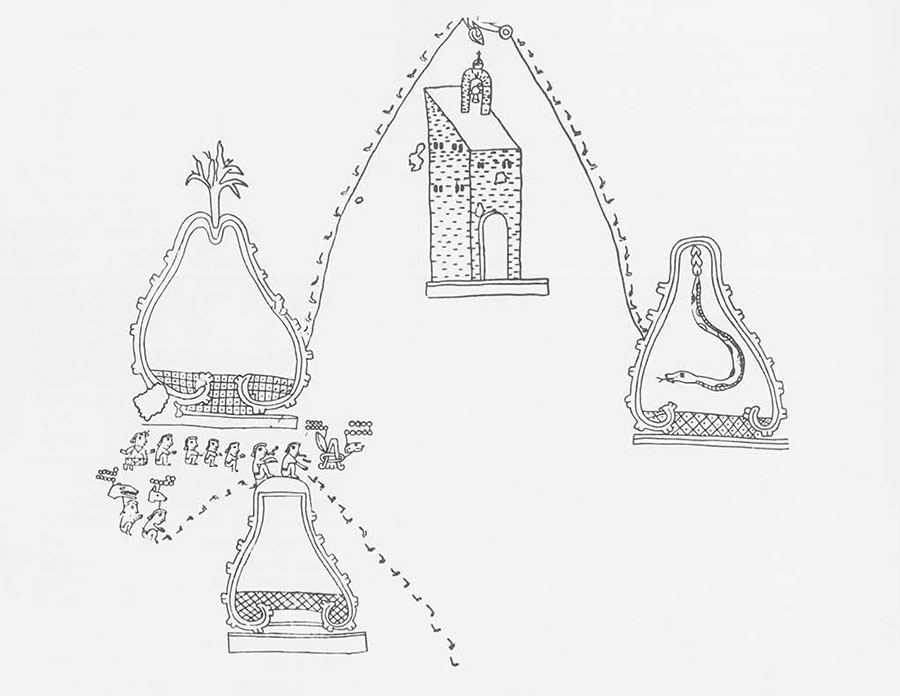
Caso does not note the difference in names between 13 Reed and 12 Reed. He notes the change of 9 Lizard to 10 Lizard, however, and flatly calls the name 10 Lizard an error, supporting his contention by calling attention to the fact that it was on a 9 Lizard day that the migration began. This investigator is not so sure about that mistake. There is evidence (see appended list) that the artist of this lienzo corrected a mistake when he made one. That he did not in this case also paint through the offending extra dot suggests he did not think he was wrong. It is hard to believe he could have left the extra dot in through an oversight when the linking footprints make comparative checking inescapable. An interesting sidelight of this place ruled by 10 Lizard is that it is the only one of the five new homes that has an arrow driven into it, signifying conquest. Perhaps it was not gained peaceably like the other four.
The problem of the changing sexes, which has long stumped Linton Satterthwaite, the curator of the Museum’s American Section, is also a puzzler to Caso. He abdicates before it, saying it is not possible to say what the native artist meant to convey.
Of the five migrating couples, we know Caso has found Lord 1 Grass and Lady 1 Eagle in other pictorial manuscripts. But he has not been able to find any of the other four. This augments the impression that the lienzo deals with rulers either in an out-of-the-way place, or in a place whose other documents have been lost.
Where is that place? Dr. Caso admits it has not been established, but he states, very cagily, that he believes the lienzo comes from what he calls the Coixtlahuaca-Tlaxiaco-Tejupam zone. And one refers to his caution because, although Coixtlahuaca and Tejupam are close together, Tlaxiaco is quite a long way from them both. By phrasing matters the way he did, Dr. Caso allowed himself almost the whole of the Mixteca and Alta as a possible provenience. This writer does not know where the lienzo came from either. But he would like to bring forward the suggestion that it comes from near San Esteban Atlatlauhca, which is south of Tlaxiaco and therefore a considerable distance from Coixtlahuaca.
The suggestion is based on the evidence in Figure 9, which shows most of the central portion of the traced version of the lienzo which Antonio Penafiel published in 1914, (and which William Gates, not knowing of the Penafiel publication, republished as Abraham Castellanos in 1931, also in traced form).
As can readily be seen, it is like the Philadelphia lienzo in that it shows three large hills. And when one looks more closely one sees further similarities. Not only are the three hills disposed towards each other in very much the same way, but the hill on the right has a conspicuous element in common, the meticulously observed rattlesnake. Then look at the lower hill. In both cases it has a rank of six men along the top (the seventh figure in the Penafiel lienzo is a woman). And although Philadelphia has four men on the left, this one resembles it in at least having two. Both lienzos depict migrations. Both are approximately the same size, and as Penafiel, who saw his in 1905, tells us, his lienzo is like Philadelphia’s in that it is made of three strips of cloth sewn together vertically. Most significant of all, the two lienzos share the same date at the hill of the migration. It is the dam 9 Lizard of the year 9 Flint.
Caso does not refer to Penafiel, but, in speculating about the year in Philadelphia’s lienzo, he says it might be the year 956 because of a migration of that year shown in Codex Nuttall. But he thinks it is more likely to be a later 9 Flint year–namely, 1112, a date falling closer to the one he calculates for the founding of Lord 3 Dog’s dynasty. He also feels 1112 is suggestive because it is so close to the destruction of Tula in 1116.
The Penafiel lienzo is influenced by European art styles in a way the Philadelphia one is not. (Witness the inclusion of the church and the three-dimensional manner of its drawing.) In fact, the Mixtec style has been so debased in the Penafiel document that the manner of indicating Mixtec names has been all but forgotten and one cannot be sure of the names of the two men. Neither of the chief likelihoods–7 Dog and 11 Alligator–appear as such in Philadelphia. So the common date and other similarities do not prove conclusively the two lienzos are from the same region. But they suggest they might be. And we have the advantage of knowing where Penafiel’s came from. Javier Cordova, who showed the lienzo to Penafiel, told him where he got it. It was the town I mentioned, San Esteban Atlatlauhca.
A small negative indication that it comes from this area rather than from around Coixtlahuaca is that there are six known lienzos from the Coixtlahuaca basin, and surely if this lienzo came from that region some of its figures would appear in the many documents we have from there.
Clearly, there is still a lot to be done for the Museum’s lienzo to be fully intelligible. But it is equally clear that it is beginning to yield its secrets. Caso, by publishing the notes he has long held, has put us all further in his debt. We have come a long way since George Vaillant bought it for the Museum in 1942 from the New York dealer, John Wise, who likes to joke how he bought it for a song as a “Persian curtain.”
Actually, he bought it as “probably Egyptian,” for that was the identifying note that went with it when William Randolph Hearst displayed it to the public for the first time when he included it in the sale of his accumulations which opened on the fifth floor of Gimbels in New York on February 3, 1941. However, the catalogue of the Hearst sale was a little more accurate than the note. On page 305 it listed the lienzo as “Primitive Latin-American Painted Linen Panel, framed (611-206).”
Hearst, unfortunately for our purposes, was an unsystematic, impulsive, voracious collector who tended to buy things in great lots, careless as to their history and often equally careless in recording where, when, and from whom he made his purchases. According to C.C. Rounds of the Hearst Corporation, the Philadelphia lienzo was one of the many things Hearst had that no one knew anything about until 1931 when a vast accumulation of stuff was moved from the Hearst garage on Eighty-fifth Street to a warehouse in the Bronx, which had been bought so the objects could be sorted and catalogued. It was then that the Philadelphia lienzo was discovered, photographed, and roughly classified.
The Lienzo de Santiago Ihuitlan Plumas, now in the Brooklyn Museum, was discovered among Hearst’s things at the same time. This Ihuitlan lienzo was stolen from its home village in 1900, and thereafter, through surreptitious hands, made its way to the United States. Probably the Philadelphia lienzo went through a similar shadowy journey. Being smaller, it would be still easier to smuggle out of Mexico.
The dimensions are worth noting. To the casual observer it is a little more than a yard high and only a small bit wider. Two of the strips are 15 1/2 inches wide; the one on the right is 13 1/2 inches. So if any one has a strip of old cotton with Mixtec paintings on it–mostly in black and white–will he please come forward? He will be especially welcome if his strip is about three feet, six inches long, and has vestiges of a date and a frayed, incomplete temple on its left side. For what he has may well be the segment of the Philadelphia lienzo that was cut away in less scrupulous days. If his strip is narrow, it may only complete the date and the temple. But if it is wide, it may have information that will illuminate the whole lienzo, to say nothing of his own holding. Let us keep our fingers crossed.
